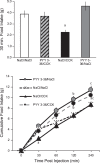NPY2 receptor activation in the dorsal vagal complex increases food intake and attenuates CCK-induced satiation in male rats
- PMID: 30726118
- PMCID: PMC6483215
- DOI: 10.1152/ajpregu.00011.2019
NPY2 receptor activation in the dorsal vagal complex increases food intake and attenuates CCK-induced satiation in male rats
Abstract
Neuropeptide Y (NPY), peptide YY (PYY), and their cognate receptors (YR) are expressed by subpopulations of central and peripheral nervous system neurons. Intracerebroventricular injections of NPY or PYY increase food intake, and intrahypothalamic NPY1 or NPY5 receptor agonist injections also increase food intake. In contrast, injection of PYY in the periphery reduces food intake, apparently by activating peripheral Y2R. The dorsal vagal complex (DVC) of the hindbrain is the site where vagal afferents relay gut satiation signals to the brain. While contributions of the DVC are increasingly investigated, a role for DVC YR in control of food intake has not been examined systematically. We used in situ hybridization to confirm expression of Y1R and Y2R, but not Y5R, in the DVC and vagal afferent neurons. We found that nanoinjections of a Y2R agonist, PYY-(3-36), into the DVC significantly increased food intake over a 4-h period in satiated male rats. PYY-(3-36)-evoked food intake was prevented by injection of a selective Y2R antagonist. Injection of a Y1R/Y5R-preferring agonist into the DVC failed to increase food intake at doses reported to increase food intake following hypothalamic injection. Finally, injection of PYY-(3-36) into the DVC prevented reduction of 30-min food intake following intraperitoneal injection of cholecystokinin (CCK). Our results indicate that activation of DVC Y2R, unlike hypothalamic or peripheral Y2R, increases food intake. Furthermore, in the context of available electrophysiological observations, our results are consistent with the hypothesis that DVC Y2R control food intake by dampening vagally mediated satiation signals in the DVC.
Keywords: hindbrain; hunger; neuropeptide; satiation; vagus.
Conflict of interest statement
No conflicts of interest, financial or otherwise, are declared by the authors.
Figures








References
-
- Abbott CR, Monteiro M, Small CJ, Sajedi A, Smith KL, Parkinson JR, Ghatei MA, Bloom SR. The inhibitory effects of peripheral administration of peptide YY(3-36) and glucagon-like peptide-1 on food intake are attenuated by ablation of the vagal-brainstem-hypothalamic pathway. Brain Res 1044: 127–131, 2005. doi:10.1016/j.brainres.2005.03.011. - DOI - PubMed
-
- Appleyard SM, Bailey TW, Doyle MW, Jin YH, Smart JL, Low MJ, Andresen MC. Proopiomelanocortin neurons in nucleus tractus solitarius are activated by visceral afferents: regulation by cholecystokinin and opioids. J Neurosci 25: 3578–3585, 2005. doi:10.1523/JNEUROSCI.4177-04.2005. - DOI - PMC - PubMed
Publication types
MeSH terms
Substances
Grants and funding
LinkOut - more resources
Full Text Sources
Miscellaneous

